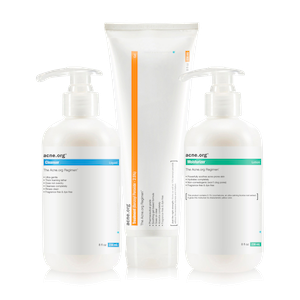The following side effects are expected to occur in the first 2-4 weeks of treatment and resolve with continued use of adapalene. Contact your doctor if these symptoms are severe and/or do not go away after 4 weeks of treatment:
How Common (based on clinical studies)
| Dryness of skin | Up to 40% of all users |
| Redness | Up to 40% of all users |
| Skin peeling or scaling | Up to 40% of all users |
| Itching | Up to 40% of all users |
| Itching immediately after application | Up to 20% of all users |
| Skin irritation immediately after application | Up to 20% of all users |
| Burning or stinging sensation | Less than 1% of all users |
| Skin irittation | Less than 1% of all users |
| Sunburn | Less than 1% of all users |
| Acne flare up | Less than 1% of all users |
Adapalene may also cause other side effects that are not mentioned here. Contact your doctor if you experience any other troublesome symptoms when using adapalene.
References
- UpToDate. Adapalene: drug information. Available from: https://www.uptodate.com/contents/adapalene-drug-information?search=adapalen&source=panel_search_result&selectedTitle=1~20&usage_type=panel&kp_tab=drug_general&display_rank=1. Cited 11 September 2024.
- Cunliffe WJ, Caputo R, Dreno B, Förström L, Heenen M, Orfanos CE, Privat Y, Robledo Aguilar A, Meynadier J, Alirezai M, Jablonska S, Shalita A, Weiss JS, Chalker DK, Ellis CN, Greenspan A, Katz HI, Kantor I, Millikan LE, Swinehart JM, Swinyer L, Whitmore C, Czernielewski J, Verschoore M. Clinical efficacy and safety comparison of adapalene gel and tretinoin gel in the treatment of acne vulgaris: Europe and U.S. multicenter trials. J Am Acad Dermatol. 36(6 Pt 2), S126-34 (1997).
- Eichenfield LF, Jarratt M, Schlessinger J, Kempers S, Manna V, Hwa J, Liu Y, Graeber M; Adapalene Lotion Study Group. Adapalene 0.1% lotion in the treatment of acne vulgaris: results from two placebo-controlled, multicenter, randomized double-blind, clinical studies. J Drugs Dermatol. 9(6), 639-46 (2010).
- Ellis CN, Millikan LE< Smith EB, Chalker DM, Swinyer LJ, Katz IH, Berger RS, Millis OH, Baker M, Verschoore M, Loesche C. Comparison of adapalene 0.1% solution and tretinoin 0.025% gel in the topical treatment of acne vulgaris. British J Dermatol. 139 (suppl 52), 41-47 (1998).
- Ioannides D, Rigopoulos D, Katsambas A. Topical adapalene gel 0.1% vs. isotretinoin gel 0.05% in the treatment of acne vulgaris: a randomized open-label clinical trial. British Journal of Dermatology 147, 523–527 (2002).
- Shalita A, Weiss JS, Chalker DK, Ellis CN, Greenspan A, Katz HI, Kantor I, Millikan LE, Swinehart T, Swinyer L, Whitmore C, Baker M, Czernielewski J. A comparison of the efficacy and safety of adapalene gel 0.1% and tretinoin gel 0.025% in the treatment of acne vulgaris: a multicenter trial. J Am Acad Dermatol, 34, 482-485 (1996).
- DailyMed. Adapalene. Available from: https://dailymed.nlm.nih.gov/dailymed/search.cfm?labeltype=all&query=ADAPALENE&pagesize=2 Cited 11 September 2024.
- Stuart B, Maund E, Wilcox C, Sridharan K, Sivaramakrishnan G, Regas C, Newell D, Soulsby I, Tang KF, Finlay AY, Bucher HC, Little P, Layton AM, Santer M. Topical preparations for the treatment of mild-to-moderate acne vulgaris: systematic review and network meta-analysis. Br J Dermatol. 185(3), 512-25 (2021).
- Tolaymat L, Dearborn H, Zito PM. Adapalene. [Updated 2023 Jun 26]. In: StatPearls [Internet]. Treasure Island (FL): StatPearls Publishing; Jan, 2024. Available from: https://www.ncbi.nlm.nih.gov/books/NBK482509/
 Acne.org Products
Acne.org Products